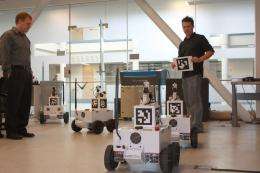UM unmanned robot team Australia bound for international competition

A smart swarm of unmanned four-wheeled robots that operate with a "hive mind" will participate in an international urban reconnaissance contest in Australia on Nov. 10.
Six students from the University of Michigan's MAGIC team, which built the bots from the ground up, depart for the games Oct. 9.
MAGIC stands for Multi Autonomous Ground-robotic International Challenge, organized by the defense departments of the United States and Australia. Its goal is to demonstrate emerging unmanned technologies. It was open to academic and industry participants. Team Michigan is one of six finalists that will vie for $1.1 million in prize money.
This contest will showcase the state of the art in autonomous robot teams that work together to perform a task.
"Our robots may be simple looking, but their intelligence sets them apart. They can sense the world and understand what they're seeing," said Edwin Olson, an assistant professor in the Department of Electrical Engineering and Computer Science who advises the team.
"The robots make almost all of their own decisions, which means that a single person can control 14 of them. They can find bombs, people, cars and other objects of interest. The robots build a map with all this information and transmit it back to the human commander in real time. Our system eliminates the need for humans to be put in harm's way."

Most research on robotics focuses on a single vehicle, Olson said. Today's military robots aren't autonomous at all, he said. There's a human nearby who, like a puppeteer, micro-manages every action. Olson's robots can divide complex tasks into smaller pieces, and split the work among multiple robots. By working in teams, the robots can tackle more difficult missions, and can complete them faster.
"In the end, these unmanned machines could mean fewer human casualties, both for soldiers and civilians caught in dangerous areas," Olson said.
The students on the MAGIC team started designing and building their machines more than a year ago.
"We have mechanically beautiful machines thanks to help from about 30 undergraduates. We built custom circuit boards and electrical systems and our own sensor system. We're using a camera and 3-d laser range finder, an inertial measurement unit, and our own wireless routing software," Olson said.
In July, they learned they had qualified for the finals, based on a site visit from contest organizers.
At the contest, they will field about 14 robots. Their tasks will be to efficiently generate a map of the terrain and neutralize any bombs or enemy combatants without harming nearby civilians in a 500-by-500-meter arena. They will have about 3.5 hours to complete three phases. Each of the six teams will run on a different day of the competition week and the winner won't be announced until Nov. 22. First place wins $750,000 in research funding.
Provided by University of Michigan

















